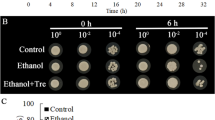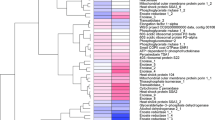Abstract
All living organisms require thiamine, a water-soluble vitamin, which is also reported to play a role in response to various abiotic stresses. However, the impact of thiamine on the growth of Wickerhamomyces anomalus under ethanol stress is still not completely understood. In this study, we investigated the effects of exogenous thiamine application on the growth of W. anomalus under ethanol stress. We also investigated how thiamine affected the differentially expressed metabolites (DEMs) using a non-targeted metabolomics approach. The results showed that exogenous thiamine application improved the growth of ethanol-stressed W. anomalus. The DEMs affected by exogenous thiamine application were significantly enriched as ABC transporters process, glycerophospholipid metabolism, purine metabolism, and one carbon pool via folate and sulfur relay system using Kyoto Encyclopedia of Genes and Genomics (KEGG) enrichment analysis. Several pathways, such as arginine biosynthesis, cell cycle, oxidative phosphorylation, etc., were also regulated by thiamine because they were not enriched after exogenous thiamine application. Therefore, thiamine helped to protect W. anomalus from the effects of ethanol stress. These findings offer a theoretical basis for further understanding the regulatory mechanism of thiamine-mediated ethanol stress tolerance in W. anomalus.






Similar content being viewed by others
REFERENCES
Abidin, A.Z., Wong, S.Y., Rahman, N.S.A., Idris, Z.H.C., and Yusof, Z.N.B., Osmotic, oxidative and salinity stresses upregulate the expressions of thiamine (vitamin B1) biosynthesis genes (THIC and THI1/THI4) in oil palm (Elaies guineensis), J. Oil Palm Res., 2016, vol. 28, pp. 308–319.
Al-Hakimi, A.B.M. and Hamada, A.M., Ascorbic acid, thiamine, or salicylic acid induced changes in some physiological parameters in wheat grown under copper stress, Plant Protection Sci., 2011, vol. 47, pp. 92–108.
Alvim, M.C.T., Vital, C.E., Barros, E., Vieira, N.M., Silveira, F.A., Balbino, T.R., Diniz, R.H.S., Brito, A.F., Bazzolli, D.M.S., Ramos, H.J.O., and Silveira, W.B., Ethanol stress responses of Kluyveromyces marxianus CCT 7735 revealed by proteomic and metabolomic analyses, A. van Leeuwenhoek, 2019, vol. 112, pp. 827–845.
Amjad, S.F., Mansoora, N., Yaseen, S., Kamal, A., Butt, B., Matloob, H., Alamri, S.A.M., Alrumman, S.A., Eid, E.M., and Shahbaz, M., Combined use of endophytic bacteria and pre-sowing treatment of thiamine mitigates the adverse effects of drought stress in wheat (Triticum aestivum L.) cultivars, Sustainability, 2021, vol. 13, p. 6582.
Auesukaree, C., Molecular mechanisms of the yeast adaptive response and tolerance to stresses encountered during ethanol fermentation, J. Biosci. Bioeng., 2017, vol. 124, pp. 133–142.
Borren, E. and Tian, B., The important contribution of non-Saccharomyces yeasts to the aroma complexity of wine: a review, Foods, 2020, vol. 10, p. 13.
Cai, W., Li, B., Chen, Y., Fu, G., Fan, H., Deng, M., Wan, Y., Liu, Na., and Li, M., Increase the content of ester compounds in blueberry wine fermentation with the ester-producing yeast: Candida glabrata, Pichia anomala, and Wickerhamomyces anomalus, Foods, 2022, vol. 11, p. 3655.
Canonico, L., Galli, E., Ciani, E., Comitini, F., and Ciani, M., Exploitation of three non-conventional yeast species in the brewing process, Microorganisms, 2019, vol. 7, p. 11.
Canonico, L., Solomon, M., Comitini, F., Ciani, M., and Varela, C., Volatile profile of reduced alcohol wines fermented with selected non-Saccharomyces yeasts under different aeration conditions, Food Microbiol., 2019, vol. 84, p. 103247.
Cheng, Y., Du, Z., Zhu, H., Guo, X., and He, X., Protective effects of arginine on Saccharomyces cerevisiae against ethanol stress, Sci. Rep., 2016, vol. 6, pp. 1–12.
Chen, Z., Lin, Y., Zhou, Q., Xiao, S., Li, C., Lin, R., Li, J., Chen, Y., Luo, C., and Mo, Z., Ginsenoside Rg1 mitigates morphine dependence via regulation of gut microbiota, tryptophan metabolism, and serotonergic system function, Biomed. Pharmacother., 2022, vol. 150, p. 112935.
Ducker, G.S. and Rabinowitz, J. D., One-carbon metabolism in health and disease, Cell Metab., 2017, vol. 25, pp. 27–42.
Escribano-Viana, R., González-Arenzana, L., Portu, J., Garijo, P., López-Alfaro, I., López, R., Santamaría, P., and Gutiérrez, A.R., Wine aroma evolution throughout alcoholic fermentation sequentially inoculated with non-Saccharomyces/Saccharomyces yeasts, Food Res. Int., 2018, vol. 112, pp. 17–24.
Fan, G., Teng, C., Xu, D., Fu, Z., Minhazul, K.A.H.M., Wu, Q., Liu, P., Yang, R., and Li, X., Enhanced production of ethyl acetate using co-culture of Wickerhamomyces anomalus and Saccharomyces cerevisiae, J. Biosci. Bioeng., 2019, vol. 128, pp. 564–570.
Fitzpatrick, T.B. and Chapman, L.M., The importance of thiamine (vitamin B1) in plant health: from crop yield to biofortification, J. Biol. Chem., 2020, vol. 295, pp. 12 002–12 013.
Goyer, A., Thiamine in plants: aspects of its metabolism and functions, Phytochemistry, 2010, vol. 7, pp. 1615–1624.
Huang, H.M., Chen, H.L., and Gibson, G.E., Thiamine and oxidants interact to modify cellular calcium stores, Neurochem Res., 2010, vol. 35, pp. 2107–2116.
Jing, H., Liu, H., Zhang, L., Gao, J., Song, H., and Tan X., Ethanol induces autophagy regulated by mitochondrial ROS in Saccharomyces cerevisiae, J. Microbiol. Biotechnol., 2018, vol. 28, pp. 1982–1991.
Kaya, C., Aslan, M., Ugurlar, F., and Ashraf, M., Thiamine-induced nitric oxide improves tolerance to boron toxicity in pepper plants by enhancing antioxidants, Turk. J. Agric. For., 2020, vol. 44, pp. 379–390.
Lin, N., Xu, Y., and Yu, X., Overview of yeast environmental stress response pathways and the development of tolerant yeasts, Systems Microbiol. Biomanufacturing., 2022, vol. 2, pp. 232–245.
Liu, X., Li, Y., Zhao, H., Yu, Z., Hardie, W.J., and Huang, M., Identification and fermentative properties of an indigenous strain of Wickerhamomyces anomalus isolated from Rosa roxburghii Tratt, Brit. Food J., 2021, vol. 123, pp. 4069–4081.
Li, Y., Long, H., Jiang, G., Gong, X., Yu, Z., Huang, M., Guan, T., Guan, Y., and Liu, X., Analysis of the ethanol stress response mechanism in Wickerhamomyces anomalus based on transcriptomics and metabolomics approaches, BMC Microbiol., 2022, vol. 22, pp. 1–13.
Naheed, R., Zahid, M., Aqeel, M., Maqsood, M.F., Kanwal, H., Khalid, N., Hashem, M., Alamri, S., and Noman, A., Mediation of growth and metabolism of Pisum sativum in salt stress potentially be credited to thiamine, J Soil Sci. Plant Nut., 2022, vol. 22, pp. 1–14.
Padilla, B., Gil, J.V., and Manzanares, P., Challenges of the non-conventional yeast Wickerhamomyces anomalus in winemaking, Fermentation, 2018, vol. 4, p. 68.
Qi, X., Su, X., Guo, H., Qi, J., and Cheng, H., VdThit, a thiamine transport protein, is required for pathogenicity of the vascular pathogen Verticillium dahliae, Mol. Plant Microbe In., 2016, vol. 29, pp. 545–559.
Rapala-Kozik, M., Kowalska, E., and Ostrowska, K., Modulation of thiamine metabolism in Zea mays seedlings under conditions of abiotic stress, J. Exp. Bot., 2008, vol. 59, pp. 4133–4143.
Saini, P., Beniwal, A., Kokkiligadda, A., and Vij, S., Response and tolerance of yeast to changing environmental stress during ethanol fermentation, Process Biochem., 2018, vol. 72, pp. 1–12.
Stanley, D., Bandara, A., Fraser, S., Chambers, P.J., and Stanley, G.A., The ethanol stress response and ethanol tolerance of Saccharomyces cerevisiae, J. Appl. Microbiol., 2010, vol. 109, pp. 13–24.
Sylvander, P., Häubner, N., and Snoeijs, P., The thiamine content of phytoplankton cells is affected by abiotic stress and growth rate, Microb. Ecol., 2013, vol. 65, pp. 566–577.
Takagi, H., Taguchi, J., and Kaino, T., Proline accumulation protects Saccharomyces cerevisiae cells in stationary phase from ethanol stress by reducing reactive oxygen species levels, Yeast, 2016, vol. 33, pp. 355–363.
Tian, S., Liang, X., Chen, J., Zeng, W., Zhou, J., and Du, G., Enhancement of 2-phenylethanol production by a wild-type Wickerhamomyces anomalus strain isolated from rice wine, Bioresource Technol., 2020, vol. 318, p. 124257.
Vamvakas, S. and Kapolos, J., Factors affecting yeast ethanol tolerance and fermentation efficiency, World J. Microb. Biot., 2020, vol. 36, pp. 1–8.
Wang, W., Fan, G., Li, X., Fu, Z., Liang, X., and Sun, B., Application of Wickerhamomyces anomalus in simulated solid-state fermentation for Baijiu production: changes of microbial community structure and flavor metabolism, Front Microbiol., 2020, vol. 11, p. 598758.
Wang, X., Xu, M., Frank, J. A., Ke, Z., and Luo, J., Thiamine deficiency induces endoplasmic reticulum stress and oxidative stress in human neurons derived from induced pluripotent stem cells, Toxicol. Appl. Pharm., 2017, vol. 320, pp. 26–31.
Wolak, N., Kowalska, E., Kozik, A., and Rapala-Kozik, M., Thiamine increases the resistance of baker’s yeast Saccharomyces cerevisiae against oxidative, osmotic and thermal stress, through mechanisms partly independent of thiamine diphosphate-bound enzymes, FEMS Yeast Res., 2014, vol. 14, pp. 1249–1262.
Zhao, M., Shi, D., Lu, X., Zong, H., Zhuge, B., and Ji, H., Ethanol fermentation from non-detoxified lignocellulose hydrolysate by a multi-stress tolerant yeast Candida glycerinogenes mutant, Bioresource Technol., 2019, vol. 273, pp. 634–640.
Funding
This study was supported by the National Natural Science Foundation of China (32 160 557).
Author information
Authors and Affiliations
Corresponding author
Ethics declarations
COMPLIANCE WITH ETHICAL STANDARDS
The authors declare that they have no conflict of interest in publishing the article. This article does not contain any studies with human participants or animals performed by any of the authors.
DATA AVAILABILITY STATEMENT
Data will be provided by the corresponding author upon request.
AUTHOR CONTRIBUTION
Contributions to the conception of the work, analysis and writing of manuscript were done by X.L. Analysis and interpretation of data for the work was done by Y.L. (Yinfeng Li), G.J, Y.L and H.L. All authors commented on previous versions of the manuscript. All authors read and approved the final version of the manuscript.
Supplementary Information
Rights and permissions
About this article
Cite this article
Li, Y.F., Jiang, G.L., Liao, Y.F. et al. Exogenous Thiamine Application Improves the Survival of Wickerhamomyces anomalus under Ethanol Stress . Microbiology 92, 658–665 (2023). https://doi.org/10.1134/S0026261723601057
Received:
Revised:
Accepted:
Published:
Issue Date:
DOI: https://doi.org/10.1134/S0026261723601057




